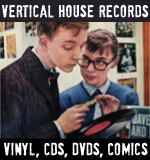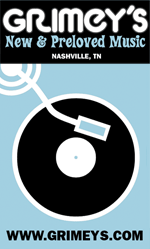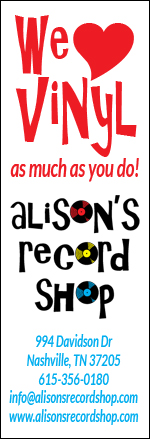 Kenneth Pattengale and Joey Ryan, better known as The Milk Carton Kids, first came together in 2011 and quickly created a signature sound based on their voices and two vintage acoustic guitars. Having self-released two collections, which were widely downloaded, their latest album, The Ash and Clay, was released by ANTI- on March 26th.
Kenneth Pattengale and Joey Ryan, better known as The Milk Carton Kids, first came together in 2011 and quickly created a signature sound based on their voices and two vintage acoustic guitars. Having self-released two collections, which were widely downloaded, their latest album, The Ash and Clay, was released by ANTI- on March 26th.
They celebrated the LPs’ street date by performing live at Hollywood’s Amoeba Records and then left for a short tour of Europe, where I queried Ryan via email:
Were records a meaningful part of your musical education?
Not until recently, but as of a few years ago, yes, profoundly. Much is made of the difference in sound enjoyed by listening to vinyl. I appreciate and love the richness and warmth, the pops and the hiss of old records. But the most important effect my conversion to an exclusive vinyl listener (at least at home) has had has been on the very nature of how I experience music.
Merely depriving oneself of the ability to easily skip tracks slows the frenetic pace of the day, allows the mind to wander and regain focus, the imagination to engage, and the listener to sink deeply in to a prolonged engagement with the performance. In this way records are able to demand the attention they deserve and require for their full appreciation.
Which albums really made an impact?
Although it was on CD, every Sunday morning Bob Dylan’s Blood On The Tracks would spin in its entirety in our house growing up, often more than once through.
For a group that offered its first two releases as free downloads, how does it feel to have physical copies of The Ash and Clay in brick-and-mortar stores?
Well, our previous album Prologue was distributed physically (albeit not as widely as The Ash & Clay) on CD and vinyl. It was important to us even then especially that vinyl be the official form of presentation, and the free download option was always just that – an option. (Many that availed themselves of it later purchased a vinyl copy as well.) But to answer straight: knowing that as we traverse North America this year our record will be on the shelves of the record stores we visit is legitimizing in a way not many other things can be. It feels more real this way.
As a two-artist ensemble, you get compared to many past and present musical pairs. Do you hear the influence of any of these duos in your music or is the comparison just an easy out for unimaginative interviewers?
Both. Aesthetically, with two guitars and two voices we expect to be received in the context of the rich history of duos throughout the last 70 or so years. We also draw important lessons on how to do something compelling with such limited instrumentation from the many who have done it before—lessons on treating harmony as counterpoint melody, lessons on dissonance and evading expectations, and on attention to detail.
As expected though, the most common comparisons seem to be to the most culturally broad duos that precede us, even though they are not actually conscious musical touchstones for us. But, everyone needs a shorthand in communicating, and the duos we get compared to are ones with whom we’re flattered to be mentioned in the same sentence.
As a guitarist and collector, vintage instruments always catch my eye. You both play older acoustics—how have these instruments shaped your music?
I don’t have a guitar besides the 1951 Gibson J-45 I play. When I hear J-45s from that era they sound to me like some platonic standard of “Guitar”. They just sound right to me, and I’ve always felt mine allows me to play a guitar the way I think it’s supposed to sound. Kenneth refers to his 1954 Martin 0-15 more in the way that it brings out a side of his playing that wouldn’t exist otherwise. It seems to have chosen him and demanded things of him, more than the other way around. Either way, the two guitars together are complementary in way we’re lucky to have discovered.
You’re in Europe now. Look out the window and describe what you see. What, if anything, will you take away from today’s experiences? Sprechen sie Deutsch?
I don’t, but they speak English here and have made us feel welcomed from the first. Currently, we sit in Cologne at the airport Starbucks looking out at an overcast sky and impressively designed modernist terminals and jetways of glass and steel. Our own song plays on the overhead speakers (honestly) which makes us self-conscious and proud. The world is small now and shrinking; it has been hard to tell whether we were in Germany or Portland at various times, which is simultaneously disappointing and comforting. We’ll be back here soon and often.
Let’s say you have an unlimited tour budget: what type of live show would you assemble? What would be the ideal venue—club, theater, amphitheater, stadium?
We need four microphones, one stool, and comfortable seats for the audience.
What do you most appreciate about your fans? What is their chief characteristic?
Mostly we appreciate that they’re there. It’s a new thing for us to have them. Hopefully, this won’t sound like cop-out, but their chief characteristic is a lack of any discernible cohesion around a certain age, gender, location, or any other grouping. They’re grandparents and their grand kids in high school, their older sisters in college and grown men our own age, too. It’s something Kenneth and I relish; that at any given show of ours so many different types of people will sit together. I wonder if they think it’s weird.
I usually refrain from questions about specific songs, but this IS Tennessee and you have a song titled “Memphis.” To me, the lyrics are nonlinear in an interesting way…is there anything you would like to say about the song? Is “Memphis” just a state of mind?
It’s a circuitous rumination, to be sure, using Memphis as a stand-in for American society as a whole, lamenting the stark contrast between the historical legends of the American story and the reality confronted today in some of the places that gave rise to them.
Upon your return from Europe, you will be appearing at The High Watt in Nashville on 4/17. Do you have any history with “Music City?” Any thoughts or impressions on the town?
Kenneth found his guitar there, and we’ve found many like-minded musical friends and colleagues there. It seems an exciting place and time in Nashville, and we usually schedule an extra day or two when the tour passes through to spend more time. To be honest though, that has been the extent of it for us. We are Californians pretty deeply, even if Kenneth calls New York home these days. Our relationship with Nashville is still burgeoning.
We seem to have arrived at a time when there is a new-found reverence for non-electric music, particularly among younger fans. Kids used to want to be Kurt Cobain, now they want to be…Marcus Mumford? Is acoustic the new black? What hath wrought this sea change?
Various aesthetic preferences continue to cycle their way through the musical mainstream, as they always have. It’s important to ignore the fluctuations, artistically. Of course, I think we’ve benefited (happily) from a zeitgeist in which we’re viewed somehow in the same light as pop bands with acoustic instrumentation. The commercial viability of a quiet folk duo is considered seriously today, so we get to do interviews like this and travel the world more easily than we might have 5 or 10 years ago.
The trouble wrought, if there is any, is in believing that there is a “revival” under way, that somehow something was lost and gone, dead or dying, and is now being resuscitated by the attention deflected its way. The tradition of meaningful stories told over acoustic instruments is an unbroken one. Popular music with that aesthetic will fall from massive mainstream grace again as it has before, but the underlying art form was never a candidate for revival. I would imagine it never will be.
Make up your own question, answer it here:
Q. Who is your daddy, and what does he do?
A. Matt Ryan, Psychologist.









